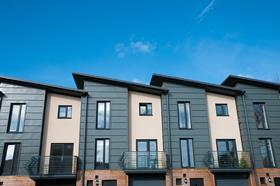The Housing Standards Review tried to consolidate a raft of different standards into Building Regulations. The trouble is, says architecture coalition 4HA, some important sustainable elements haven’t made it across

The Housing Standards Review carried out a thorough assessment of the complex and sometimes contradictory network of standards and legislation relating to UK housing provision. This resulted in a condensed set of standards being moved to either planning legislation or the Building Regulations. With the proposed withdrawal of the Code for Sustainable Homes some of the important categories have been retained, but many will be abandoned. While the Code for Sustainable Homes is outdated in many aspects, there are some elements essential for the quality and sustainability of new homes and that will not be satisfactorily dealt with under the new proposals.
The housing industry needs a long-term plan for the sustainable future of the sector, setting out the trajectory of regulations up to a decade ahead while giving the sector the certainty to plan investment and future housing solutions. We think the next government should use the Housing Standards Review to develop and incorporate the missing sustainable elements into regulation.
The process so far
The Housing Standards Review set out to relocate a simplified set of standards into the Building Regulations, tackling a large number of issues at once, including sustainability. The process involved engagement with the industry and use of a Challenge Panel to ensure that key issues (energy, water, security, accessibility and space) were dealt with collaboratively. However, this process has also highlighted some of the wider sustainability issues left behind. The Challenge Panel report, Towards More Sustainable Homes, noted a concern for issues not fully considered such as daylight, sunlight, overheating and materials.
The real win was the migration of a simplified set of standards into Building Regulations, giving the industry a robust set of regulations to work to. Yet the review panel and the government acknowledged there are still issues to be reviewed at a later date.
Missing elements
The decision to wind down the Code for Sustainable Homes is broadly welcomed, but most of the issues it dealt with have not transferred into the other regulations, leaving a number of gaps. The Housing Standards Review has neglected air quality, improved sound insulation, over-heating, daylighting, materials, ecology and as-built energy performance, to name a few. Some of these issues (air quality, overheating and performance gap) are subject to continuing research by the Zero Carbon Hub and the Building Regulations Advisory Committee, but some have been missed out altogether (daylighting, materials and improved sound insulation). These are popular issues with consumers and developers alike, and yet have been left behind by the review.
The opportunity to introduce space labelling has been missed and would have ensured that purchasers and renters received clear transparent information about the standards of homes. Meanwhile, the uncertainty surrounding delivery of future zero-carbon homes is making decisions for planned developments more difficult.
Below is a list of key issues relevant to the sustainability of the housing stock that should be examined by a short and long-term strategic effort made by industry and the government.
Immediate short-term issues:
- Daylight and sunlight
- Mitigation of overheating
- Post-construction performance
- Indoor air quality
- Ecology and biodiversity
- Improved acoustic performance
Wider issues to be considered in the long term:
- Health and wellbeing
- Closed loop approach to materials
- Climate change resilience and adaptation
- Economic growth through sustainable investment
A consumer-led framework
4HousingArchitects is a group comprising the principals of four of the UK’s leading design practices specialising in housing: HTA Design LLP, Levitt Bernstein, PRP and Pollard Thomas Edwards. Subject to reasonable baselines, 4HA proposes to re-frame housing standards in terms that resonate with the consumer. If we are going to deliver increased volumes as well as better quality and sustainable housing, demand from the consumer is a sure-fire way of transforming markets. For example, if the headings of Structure, Safety and Sustainability are used in Building Regulations, technical guidance could have a new home within a restructured set of Approved Documents. These would be presented in terms that are familiar to consumers and reassure them that the industry is meeting their needs.
This standard industry label for new homes will provide comparable information on the important issues for consumers. The Housing Forum Home Performance Pilot is an example that 4HA has worked on to educate consumers and advertise new homes against transparent benchmarks.
In summary, there are many positive points to be taken from the Housing Standards Review, some areas for further improvement and evidence of a commitment to continue, as well as some poor aspects surrounding sustainability which are not too late to redress. All of these can be dealt with in a continuation of the review process already started, giving confidence to the industry and to end users that the industry will produce sustainable homes that meet their needs.
Rory Bergin, partner, Sustainable Futures, HTA Design
Tom Dollard, associate, head of sustainable design, Pollard Thomas Edwards
Clare Murray, head of sustainability, Levitt Bernstein
Andrew Mellor, partner, PRP Environmental, PRP Architects




























No comments yet